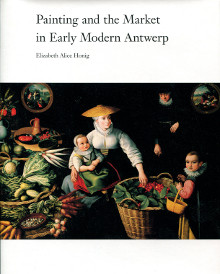ARTICLES

Painting and the Market in Early Modern Antwerp
Honig, Elizabeth Alice
Yale University Press, New Haven & London, 1998.
Petit-in-4, pleine toile éditeur avec dos titré sous jaquette illustrée en couleur, xi - 308 pp.
Avec 100 illustrations en noir et en couleurs in et hors-texte.
Bon état. Un pli sur la jaquette.
Livre non disponible
"This important book explores the ways in which Flemish painting between 1550 and 1650 both represented and reflected the burgeoning capitalism of Antwerp, the major port of Europe at that time. Elizabeth Honig focuses not only on market-scene paintings but also on the interaction between painters and markets as it was influenced by the changing roles played by merchants, church and city governments, and consumers.
"Honig discusses the paintings of Pieter Aertsen and his nephew Joachim Beuckelaer within the context of a developing aesthetic of exchange, as art became increasingly defined as an alluring commodity that aroused in its beholder a desire for possession and called upon the tempering forces of individual reason and self-judgment. She then examines the relation between painting and the market that emerged in Antwerp after the Spanish reconquest, a period of social, economic, and religious retrenchment. Analyzing works by Frans Snyders, Jan Bruegel, and others, she shows how the dynamism of market commerce was pictorially masked to provide an illusion of stasis : still-life painting became the inheritor of -and subverter of -the market scene. Finally she considers the implications of an aesthetic of display within a newly dominant manner of artistic production (connoisseurship), as painters tried to produce works that would appeal to the tastes of consumers. She argues that the roots of certain modern ways collecting and valuing painting lay within this change in aesthetic priorities."
Elizabeth Alice Honig enseigne à l'university of California, Berkeley.
"Honig discusses the paintings of Pieter Aertsen and his nephew Joachim Beuckelaer within the context of a developing aesthetic of exchange, as art became increasingly defined as an alluring commodity that aroused in its beholder a desire for possession and called upon the tempering forces of individual reason and self-judgment. She then examines the relation between painting and the market that emerged in Antwerp after the Spanish reconquest, a period of social, economic, and religious retrenchment. Analyzing works by Frans Snyders, Jan Bruegel, and others, she shows how the dynamism of market commerce was pictorially masked to provide an illusion of stasis : still-life painting became the inheritor of -and subverter of -the market scene. Finally she considers the implications of an aesthetic of display within a newly dominant manner of artistic production (connoisseurship), as painters tried to produce works that would appeal to the tastes of consumers. She argues that the roots of certain modern ways collecting and valuing painting lay within this change in aesthetic priorities."
Elizabeth Alice Honig enseigne à l'university of California, Berkeley.
